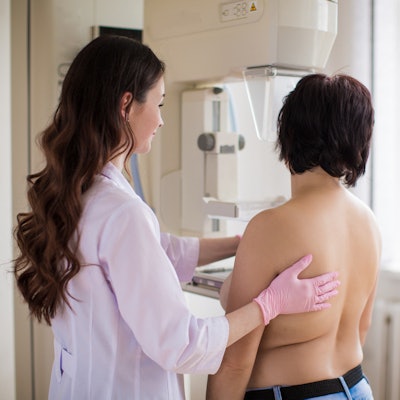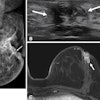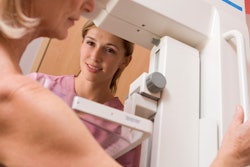
The transition from digital mammography to digital breast tomosynthesis (DBT) for routine breast cancer screening has its benefits, such as lower recall rates and better cancer detection. But DBT also leads to higher healthcare costs, according to research presented at the recent RSNA 2018 meeting.
"Digital breast tomosynthesis is replacing digital mammography as the modality for routine breast cancer screening in the U.S., and its benefits include reduced recall rates and improved cancer detection rates," said presenter Dr. Kathryn Lowry of the University of Washington in Seattle. "But its effect on long-term screening outcomes and cost-effectiveness is unknown."
Lowry and colleagues sought to project long-term outcomes and cost-effectiveness of the transition from breast cancer screening using digital mammography to screening with DBT. The group used two statistical models to simulate scenarios for women age 40 and older from 2011 and 2020:
- Continued use of digital mammography alone
- Complete transition from digital mammography to DBT
The researchers estimated the performance of digital mammography and DBT using screening data from the U.S. National Cancer Institute's Population Based Research Optimizing Screening through Personalized Regimen (PROSPR) consortium from 200,000 women who underwent either digital mammography or DBT between 2011 and 2014. They based costs and quality-of-life estimations on U.S. national averages and published literature, and the team used 2017 U.S. Centers for Medicare and Medicaid Services (CMS) reimbursement rates for screening digital mammography ($138.17 per exam) and screening DBT ($194.52 per exam).
The researchers then projected the data on cost and quality of life through 2020, with the assumption that women would either receive digital mammography alone over the time period or receive exclusively DBT.
The transition to DBT had the greatest effect on false-positive rates, with a reduction in false positives of 24% to 28%, Lowry and colleagues found. But DBT's gains for other performance metrics were modest -- and its costs were higher, in particular as measured by quality-adjusted life years (QALYs) and incremental cost-effectiveness ratio (ICER), statistical tools that assess the cost-effectiveness of a healthcare intervention.
The group provided DBT numbers for two scenarios: one in which DBT's sensitivity was equivalent to digital mammography, as was the case in the PROSPR data. But since some recent studies are indicating a sensitivity advantage to DBT, they also provided numbers with DBT at a 4% sensitivity gain.
| Impact of DBT on breast screening | |||
| Metric (per 1,000 women) | Digital mammography (DM) | DBT at 0% sensitivity gain over DM | DBT at 4% sensitivity gain over DM |
| Reduction in false-positive exams | NA | 24% to 28% | 24% to 28% |
| Breast cancer deaths averted | NA | 0 to 0.21 | 2.17 to 2.68 |
| Life years gained | NA | -1 | 0.05 |
| QALYs gained | NA | 1.74 to 2.28 | 2.58 to 3.35 |
| Incremental cost-effectiveness ratio per QALY | NA | $184,466 to $243,276 | $133,725 to $147,690 |
The ICER numbers for DBT in the study were somewhat higher than the "willingness to pay" benchmark of $100,000 to $150,000, the level at which a test is determined to be worth paying for. But things change if the assumptions in the statistical model are tweaked, the researchers found, specifically the sensitivity for DBT and the level of reimbursement.
For example, ICER decreased to $141,043 per QALY with a 2% absolute improvement in DBT sensitivity. If sensitivity stayed the same but reimbursement for a DBT exam were cut by $20, ICER decreased to $163,092 per QALY and to $59,872 per QALY with a $40 reduction.
The bottom line? Implementing DBT likely results in modest improvements in breast cancer mortality and life expectancy in U.S. women, but significantly reduces false-positive exams, Lowry said. However, the costs incurred relative to benefits are high, based on current estimates of DBT's performance and reimbursement rates, she said.
"DBT screening could be cost-effective at lower reimbursement rates," she concluded.




















